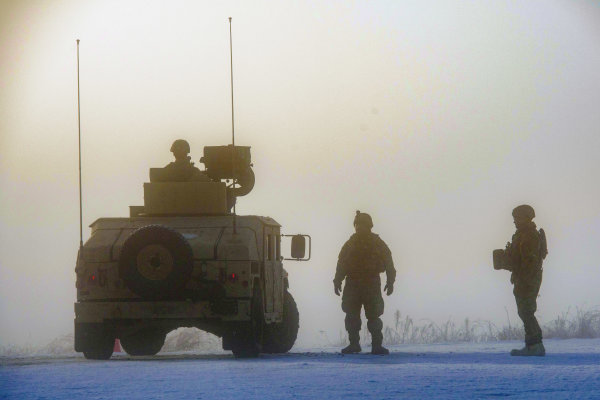

By John Bolton
Among the islands of Micronesia, a strange phenomenon occurred after the first Westerners arrived. Not understanding how industrialization had created ships, guns, and cannons, the islanders assumed a strikingly similar response: presuming magic had given the whites “Cargo.” Soon, emergent “Cargo Cults” preached a forthcoming doctrine of abundance, believing that if they built the artifices of “Cargo” such as wooden docks, bamboo roads, and dirt airfields, the goods would return.
If at first inclined to scoff at stone-age ignorance, we should consider that the Army’s implementation of Mission Command follows a similar pattern. The natives mistook the artifacts of “Cargo” from supporting its factors, processes, and systems just as the U.S. Army is mistaking mission orders and disciplined initiative as the tools of Mission Command rather than a changed Culture.
Consequently, Cargo Cultists provide an example of how not to implement change — one the Army should consider as it struggles to make Mission Command a reality.
An Army “that operates according to the principles of Mission Command does not naturally appear, especially in peacetime,” regardless of the historical truths enshrined in Mission Command Doctrine. Doctrinal changes alone are insufficient to create the flexible, empowered organizations Mission Command envisions. Army organizational culture must also undergo a transformation—more than just “declaring it so.” As Jon Kotter stated in Leading Change, results “come last, not first.” At present, the Army has not made necessary, systematic adjustments to its personnel and leader development programs while remaining infatuated by, and immune to the limitations of, technology.
Personnel system
Mission Command requires trust and time, two factors made nearly impossible by the Army Personnel System, which fosters turnover exceeding 30% every six months. For officers, rapid, mandatory time KD positions fosters careerism even as Army Culture/Doctrine condemns it. For officers, passage through the system has become a cursus honorum, moving rapidly through jobs to meet promotion gates.
Turnover is doubly pernicious because it engenders the nemesis of Mission Command: micromanagement. Short-term leaders inevitably focus on short-term goals, engaging in “firefighting,” a cycle of executing trivial, time-consuming actions ultimately unrelated to unit success (think of most metrics associated with the Defense Travel System). Short-term personnel practices have also created a situation where the Army may be inadvertently encouraging and sanctioning institutional deception.
Technology
Army Digital Mission Command Systems (DMCS) supposedly create a seamless common operational picture (COP). The problem is this COP is often fictitious; fog and friction cannot be eliminated, proposing otherwise is fallacy. Consequently, DMCS inhibit the practice of Mission Command because they produce a false picture that acutely inhibits subordinate initiative as we fixate on systems rather than operations. Problematically, the digital COP is authoritative in ways an analog map is not. Consequently, the discipline required to disagree with the digital COP is often unrealistic.
Any technological dominance will be fleeting; adversaries will seek to either mitigate our advantage through maneuver or fires, or simply operate in a way that ameliorates our strength. Management expert Peter Drucker stated “culture eats strategy for breakfast.” This means shared ethos, values and ethics reflect organizational priorities more than official documents—economists call this revealed preference. Culture’s primacy over technology are precisely why the Army needs Mission Command. Mission Command practices are more effective than high-tech systems.
Conclusion: Mission Command is the way forward
The Army’s typical approach to engendering change—designating a priority, creating “master trainers”, and adding new requirements—is “timeworn, simple, predictable” and, ultimately, ineffective. Failing here leads to Mission Command being “lost in transmission.” Lasting organizational change requires more than PowerPoints which are “Band-Aids for systematic organizational problems.”
Cultural change takes serious buy-in from leaders and a commensurate change in everything from recruiting to education to training management and the conduct of exercises. The Army should look to implement training that fosters initiative through challenging decision-focused scenarios that, critically require leaders to disobey orders. Moreover, training must pull the plug of technology from even large-scale exercises. Doing otherwise will continue the trend toward centralization and presumption of information dominance, both pernicious.
The Army has made genuine progress toward Mission Command implementation—modifying doctrine is a good first step. But marginal changes are insufficient. The Army should revamp junior officer training to support challenging scenarios requiring disciplined initiative with uncertain information, rather than relying on superiors from afar.
Concurrently, the Army would be wise to retool its personnel system to inculcate initiative by reducing moves and one-way career tracks. Doing so will engender leaders committed to organizational success and developing capabilities—the kind of leaders who leverage technology, rather than rely on technology.
Failing to make key structural, organizational, and training changes will ensure that Mission Command remains a goal rather than reality, and that Mission Command will remain a “Cargo Cult,” reflecting simply the artifice but not the reality of the disciplined initiative, mission orders, and decentralized execution.
John Bolton is the Executive Officer for 2-25 Assault Helicopter Battalion. He is a graduate of the Command and General Staff College’s Art of War Scholars Program and holds degrees from West Point and American Military University. His assignments include 1st Engineer Battalion, 1-1 Attack Reconnaissance Battalion, and 4/25 IBCT (Airborne) with multiple deployments to Iraq and Afghanistan. The views presented here are his alone and not representative of the U.S. Army, the Defense Department, or the U.S. government.